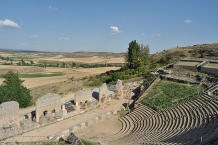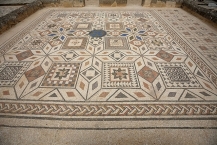Clunia
Sehenswürdigkeiten
Erstellt am 31.01.2021,
zuletzt geändert von biroto-Redaktion am 31.01.2021
Radwege und Fahrrad-Touren in der Nähe
| Name/Bezeichnung | Typ | km zur Strecke |
|---|---|---|
Route | 0,7 km | |
Route | 2,6 km | |
Tour | 0,7 km |
![]()
Bitte warten - Kartendaten werden geladen
Art der Sehenswürdigkeit
Bodendenkmal
Name u. Anschrift
Clunia
∎∎∎∎∎∎ ∎∎∎∎∎∎∎∎ ∎∎ ∎∎∎∎∎∎
ES-09410 Coruña del Conde
GEO-Daten
GEO-Koordinaten
41.78∎∎∎∎ -3.37∎∎∎∎
Höhe
1023 m
Kommunikation
Tel.
+34 ∎∎∎ ∎∎∎∎∎∎
Internet
∎∎∎.∎∎∎∎∎∎.∎∎/
∎∎∎∎∎∎@∎∎∎∎∎∎∎∎∎∎∎∎∎∎∎∎∎∎.∎∎
Informationen zu Urheber-Rechten | |
|---|---|
Rechte-Inhaber | |
Rechte-Ausprägung / Lizenz | by-sa: CREATIVE COMMONS Namensnennung, Weitergabe unter gleichen Bedingungen |
Link zur Rechtebeschreibung | |
Bild übernommen aus | https://commons.wikimedia.org/wiki/File:Clunia_Sulpicia_(Peñalba_de_Castro)_-_001_(35754335521).jpg |
Bild hochgeladen | durch biroto-Redaktion am 31.01.2021
|
Informationen zu Urheber-Rechten | |
|---|---|
Rechte-Inhaber | |
Rechte-Ausprägung / Lizenz | by-sa: CREATIVE COMMONS Namensnennung, Weitergabe unter gleichen Bedingungen |
Link zur Rechtebeschreibung | |
Bild übernommen aus | https://commons.wikimedia.org/wiki/File:Termas_de_Clunia_(Burgos).jpg |
Bild hochgeladen | durch biroto-Redaktion am 31.01.2021
|
Informationen zu Urheber-Rechten | |
|---|---|
Rechte-Inhaber | |
Rechte-Ausprägung / Lizenz | by-sa: CREATIVE COMMONS Namensnennung, Weitergabe unter gleichen Bedingungen |
Link zur Rechtebeschreibung | |
Bild übernommen aus | |
Bild hochgeladen | durch biroto-Redaktion am 31.01.2021
|
Clunia (full name Colonia Clunia Sulpicia) was an ancient Roman city. Its remains are located on Alto de Castro, at more than 1000 metres above sea level, between the villages of Peñalba de Castro and Coruña del Conde , 2 km away from the latter, in the province of Burgos in Spain. It was one of the most important Roman cities of the northern half of Hispania and, from the 1st century BC, served as the capital of a conventus iuridici in the province Hispania Tarraconensis, called Conventus Cluniensis. It was located on the road that led from Caesaraugusta (Zaragoza
) to Asturica Augusta (Astorga
). The city declined during the 3rd century and was largely abandoned by the Visigothic era.Clunia is a toponym of Arevacian origin.
Archaeological remains
Clunia constitutes an archaeological enclave of exceptional interest in a collection of the Iberian Peninsula. This interest is determined by its urban morphology and by the cultural sequence of the findings that it provides. Also, its ruins are the most representative of all the ones that have been found of the Roman period in the north of the Iberian Peninsula.
The archaeological excavations in the deposit began in 1915. The work resumed in 1931 and 1958, bringing to light the glorious past of one of the principal cities of Hispania whose extension — judging by the archaeological excavation — neared 1.2 square kilometres, this being one of the largest cities of all of Roman Hispania. The excavations permitted the discovery —after centuries of being hidden— a theater excavated into rock, various domus with mosaics, streets, ruins of the buildings of the forum and a great cloaca, just as important sculptural findings, like an effigy of Isis and a torso of Dionysus, which are preserved at the National Archaeological Museum of Spain and in that of Burgos, including a large quantity of coins, epigraphic ruins, Roman ceramics such as Samian ware, glass and bronze objects.
Informationen zu Urheber-Rechten | |
|---|---|
Rechte-Ausprägung / Lizenz | by-sa: CREATIVE COMMONS Namensnennung, Weitergabe unter gleichen Bedingungen |
Link zur Rechtebeschreibung | |
Text(e) übernommen von: |
Wikipedia contributors, 'Clunia', Wikipedia, The Free Encyclopedia, 19 November 2020, 08:06 UTC, https://en.wikipedia.org/w/index.php?title=Clunia&oldid=989489596 [accessed 31 January 2021] |
übernommen / bearbeitet am | 31.01.2021
|
übernommen / bearbeitet durch |
|
Öffnungszeiten:
Winter - October 1 - March 31
Tuesday to Sunday from 10 a.m. to 2 p.m. and from 3 p.m. to 5 p.m.
Summer - April 1 - September 30
Tuesday to Sunday from 10 a.m. to 2 p.m. and from 4 p.m. to 8 p.m.
Radwege und Fahrrad-Touren in der Nähe
| Name/Bezeichnung | Typ | km zur Strecke |
|---|---|---|
Route | 0,7 km | |
Route | 2,6 km | |
Tour | 0,7 km |
Erstellt am 31.01.2021,
zuletzt geändert von biroto-Redaktion am 31.01.2021



